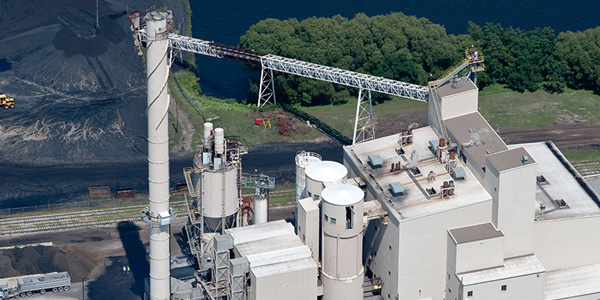By Rich Heidorn Jr.
FERC on Friday rejected CMS Energy’s plan to boost a 60-MW qualifying facility to 263 MW, saying the change is too large to qualify for recertification under the Public Utility Regulatory Policies Act (EL18-123, QF87-481-002).
The company sought to recertify as an existing cogeneration QF its T.E.S. Filer City Station facility in Manistee County, Mich. The facility has two boilers that can burn coal, tire-derived fuel and waste wood and creates 60 MW of electricity that is sold to CMS subsidiary Consumers Energy. It also provides about 50,000 pounds per hour of process steam to the facility’s thermal host, a paper mill owned by Packaging Corporation of America.
CMS proposed replacing the solid fuel boilers with a natural gas-fired combustion turbine and heat recovery boiler to be used with the existing steam turbine that would produce approximately 263 MW of net electrical output while providing the same thermal output to the mill. The company said a smaller turbine and boiler would not provide enough waste heat to efficiently operate the existing steam turbine and serve the mill.
The 2005 Energy Policy Act modified PURPA, requiring that any new cogeneration facility demonstrate that its “thermal energy output … is used in a productive and beneficial manner,” and that its electrical output be used fundamentally for industrial or other permitted uses “and is not intended fundamentally for sale to an electric utility.”
To implement the changes, the commission in Order 671 created a “fundamental use test,” allowing the thermal output from a replacement cogenerator to be considered to be “used in a productive and beneficial manner” if at least 50% of the total energy output (the electric, thermal, chemical and mechanical output) is used for industrial or other permitted purposes.
Order 671 said that an existing QF does not become a new facility “merely because it files for recertification. However, we caution that changes to an existing cogeneration facility could be so great (such as an increase in capacity from 50 MW to 350 MW) that what an applicant is claiming to be an existing facility should, in fact, be considered a ‘new’ cogeneration facility at the same site.”
FERC said CMS’ proposed changes are too significant to qualify for recertification as an existing facility.
“The increase in net capacity from 54 MW to 263 MW constitutes so substantial an increase in capacity that … it cannot be considered the same facility that was previously certified,” the commission ruled. “Rather, the converted facility, as proposed, is a ‘new’ cogeneration facility.”
The commission said CMS had not provided information demonstrating that it meets the fundamental use test. “Accordingly, on the record before us, we cannot certify the facility, if converted as proposed, as a cogeneration QF. T.E.S. Filer is free to file such information with the commission by either submitting a self-certification or applying for a commission certification of QF status.”
Dissent by LaFleur
Commissioner Cheryl LaFleur dissented.
“I do not read [Order 671] as requiring any significant increase in megawatt output to be treated as a change so great as to consider a facility a ‘new cogeneration facility at the same site,’” she said. “The record here shows that the conversion was designed to meet the needs of the thermal host, and that the increased megawatt output is simply a byproduct of meeting that existing need with a modern, efficient gas turbine. I believe those facts are the pertinent ones for determining here whether the changes are ‘so great’ as to warrant denying recertification.”
LaFleur noted that PURPA requires the commission’s rules to encourage cogeneration facilities. “Unfortunately, interpreting Order No. 671 in a manner that requires rejection in this instance may in fact discourage other cogeneration resources from updating and optimizing their systems, for fear of no longer maintaining their QF status. I do not believe that outcome is justified on this record.”
Separately, FERC approved CMS’ request for a declaratory order confirming that its power purchase agreement with Consumers will remain exempt from Federal Power Act Sections 205 and 206 after the PPA is amended to reflect the upgrades to the facility (EL18-124, QF87-481-003). “Assuming for the sake of this discussion that T.E.S. Filer is a QF, sales made pursuant to the PPA, as amended … will continue to be exempt from commission oversight pursuant to FPA Sections 205 and 206.”





